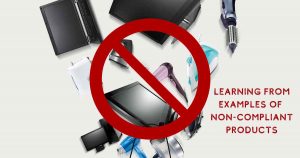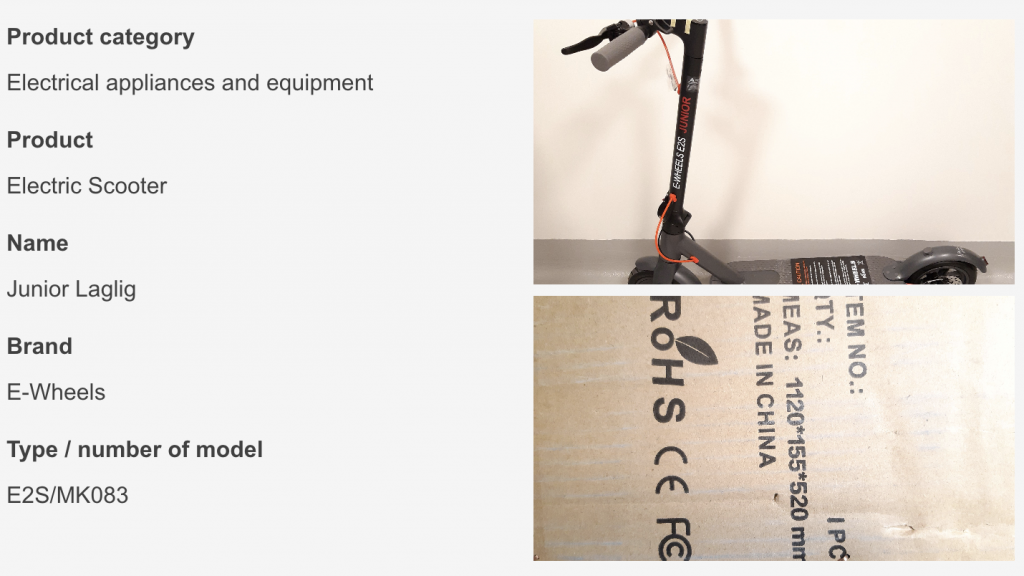What is the best way to familiarize yourself with the safety risks in your product category? I’d say you should look at recent recalls and lawsuits on non-compliant products similar to yours. There is a lot to learn.
Here are two examples.
First, an e-scooter that doesn’t even pass an EU RoHS 2 test
This is a fast-growing product category and it has attracted many Chinese companies that have no idea how to ensure their products are acceptable in importing countries.
I found it in Alert number: A12/00962/23 in the European Union’s registry of dangerous non-food products.
They show a number of logos:
Actually, when there is a RoHS sign (which is NOT required and is nothing official in the RoHS directive) larger than a CE sign (definitely a must here), it is suspicious and likely to call the attention of market surveillance authorities…
Why did it get caught? The product did not pass a simple RoHS test!
(Note: we wrote about how a product is tested against RoHS requirements on this page. It is not a very expensive test. In fact, testing just for restricted metals, such as lead, is much faster & cheaper.)
Risk description
Different parts in the scooter have an excessive concentration of lead (measured value up to 54.9 % by weight). Lead poses a risk to the environment.
Legal provisions (at EU level) and European standards against which the product was tested and did not comply
The product does not comply with the requirements of the Directive on the restriction of the use of certain hazardous substances in electrical and electronic equipment (RoHS 2 Directive).
Measures taken by economic operators (Importer)
Stop of sales
Typical root causes of non-compliant products made in China
Is this typical of relatively cheap electrical/electronic products made in China by inexperienced companies? Unfortunately, yes, it is rather common. The root causes of non-compliant products like this are as follows:
- Lack of awareness of compliance requirements at the manufacturer, who probably don’t even try to avoid solder paste that contains lead (a very, very basic point)
- Disregard for compliance requirements on the part of the importer, who probably never got bothered by market surveillance authorities before
Second, ladies’ underwear (specifically for periods) with ‘forever chemicals’
This case is interesting on several levels. It is described in a press article (What to Know About PFAS in Period Underwear):
This week, the period underwear brand Thinx made public that it had reached a settlement in a 3-year-long class action lawsuit claiming its products contain harmful chemicals. The news of the settlement brought renewed focus on the chemical compounds at the center of the lawsuit — per- and polyfluoroalkyl substances, known as PFAS or “forever chemicals” — and highlighted the broader issue of toxic ingredients in period products as a whole.
Period underwear are designed to work a little like a traditional menstrual pad in that they can soak up blood but, unlike a disposable pad, the underwear can be washed and reused. The presence of PFAS in Thinx products was first revealed in January 2020, when Sierra magazine published an investigation, in partnership with a researcher at the University of Notre Dame, that found these chemicals in the crotch area of Thinx underwear. Later that year, at least three different lawsuits filed against Thinx included further evidence from third-party testers of PFAS and other toxins in the underwear.
Eventually, a number of the lawsuits consolidated into one class-action case and the company reached a settlement at the end of last year. On Tuesday, consumers could begin applying for refunds for up to three pairs of Thinx underwear.
What are the learnings here?
First, this issue was detected by a product user who arranged for a chemical test and published her results online. There may be more and more of this in the future.
Second, lawyers worked on a class action lawsuit. This got pretty serious.
Third, the CPSIA or the FDA haven’t restricted those substances (as far as I know), but lawyers sued the company based on the fact that those chemical substances have been found to be correlated with cancer. They are unsafe, while the brand’s message insisted the products were “non-toxic”. Be careful with your marketing claims…
Fourth, this product is classified as a medical device, which is a highly regulated product category. I’d expect a successful and “grown up” company to have tested the fabric of their underwear more thoroughly…
If you want to know more about non-compliant products and product compliance…
Clive Greenwood, a compliance consultant, has organized a seminar on compliance management on Saturday the 6th of May (later this week) in Shenzhen. I’ll be one of the speakers.
Here is the agenda:
- ISO 37301:2021 and the Liability Laws
- EU Regulations and Compliance Standards
- ISO10337:2013 and Product Safety Law
- Eco Design and Sustainability Act
- LCA and EPD for EU imports
- Risk Management for Exported Products.
If you are interested in joining, please contact Clive through Linkedin or message me. Hope to see you there!
Disclaimer
We are not lawyers. What we wrote above is based only on our understanding of legal requirements. QualityInspection.org does not present this information as a basis for you to make decisions, and we do not accept any liability if you do so.


